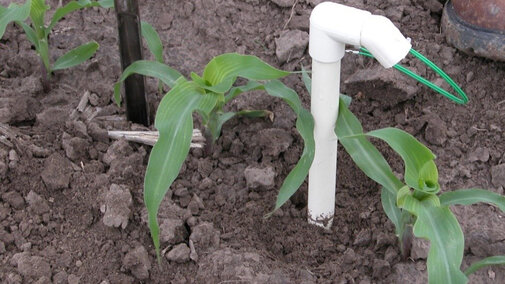As planting progresses across the state, it is recommended that irrigators start installing water sensors in fields as time allows. Any time sensors are installed, a few simple questions should be addressed to ensure accurate readings for irrigation management later this season.
1) When should sensors be installed?
Ideally, sensors should be installed as soon as possible after crop emergence to minimize root damage and allow the sensor time to acclimate with the soil (Figure 1). As plants mature, sensor installation may result in damaged plants and roots close to the sensor, resulting in altered readings compared to healthy plants. Depending on the sensor installed, initial readings may reflect water within the sensor or from the surrounding slurry, so time needs to be given to let soil water conditions even out.
While some areas of Nebraska are experiencing wet conditions right now and irrigation season seems far off, early installation of sensors is still highly recommended.
2) How many sensors should be used?
This is going to depend on the variability in soil texture, slope, and crops within a given field. In a uniform field, one station of sensors should provide a good estimate of soil water conditions. A station would consist of three or four Watermark® (Irrometer Co., Inc., Riverside, CA, USA) sensors or one capacitance sensor.
With more variable fields, an increasing number of sensor locations would provide a more accurate picture of soil water content throughout the field. Different crops within the same field would also need additional sensor locations to reflect their different crop water use patterns.
3) Where in the field should sensors be installed?
When installing only a single sensor station within a field, it is critical to install sensors in the most representative spot, making sure to avoid low areas, poor stands, or steep slopes. If desired, companies do offer assistance with selecting locations for sensors based on soil physical properties and field history. Placement also depends on the type of sensor used. For instance, basic Watermark sensors that will be read using a handheld meter will need to be placed somewhere easily accessible to ensure that they are used during the season. Sensors using a telemetry system such as radio, cellular, or satellite help ensure that an ideal location can be selected regardless of ease of entry during the season.
4) Dry fit versus slurry installation?
This will depend on the type of sensors installed and the soil texture. For Watermark sensors, we would recommend using a dry fit installation as research shows this gives the best soil contact to ensure an accurate soil reading. Dry installations require a properly sized soil probe and may be challenging in high clay soils. For more information on installing Watermark sensors, refer to EC783 Principles and Operational Characteristics of Watermark Granular Matrix Sensor to Measure Soil Water Status and Its Practical Applications for Irrigation Management in Various Soil Textures or view the installation video at https://www.youtube.com/watch?v=M_dBCOzFSAE.
With capacitance sensors, close contact with the soil adjacent to capacitors is needed. To address this, during installation some companies use a slurry installation (i.e., mixture of soil and water). The downside of this installation method is the soil structure of the slurry does not represent the surrounding soil. This downside will need to be weighed against the possibility of air gaps with a dry installation. In some cases this still may be the best option.
5) Is there anything I need to do before installation and how long do sensors last?
Sensors need to be checked before installation to ensure that they are reading properly. When dry, sensors should read 199 kPa. After soaking in water for 10-15 minutes, sensors should read between 0-10 kPa. Values higher than this likely indicate that the sensor needs to be replaced. Watermark sensors should typically last for at least three to four growing seasons.
Before you go to the field to install Watermark sensors, be sure to put the sensors in water and install them wet to eliminate air in the sensor (Figure 2).
More information about how to assemble and prepare Watermark sensors is available in this video, https://www.youtube.com/watch?v=jpEsjVO497A


